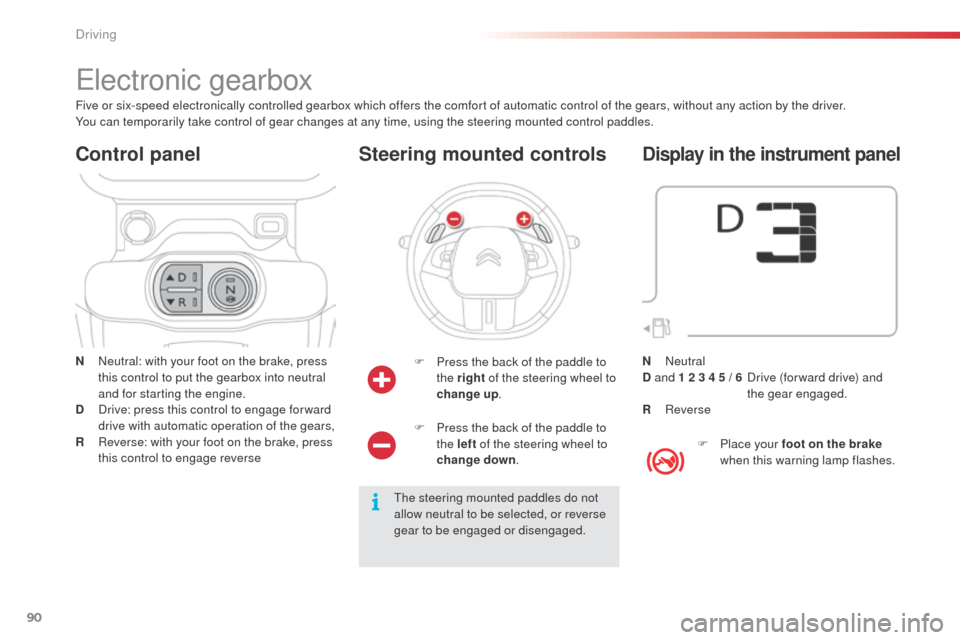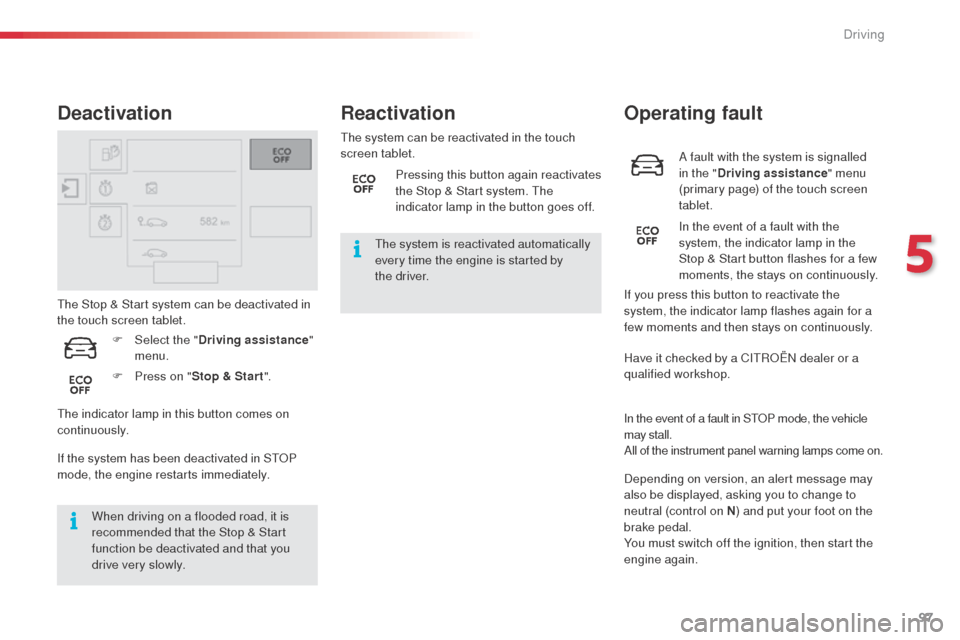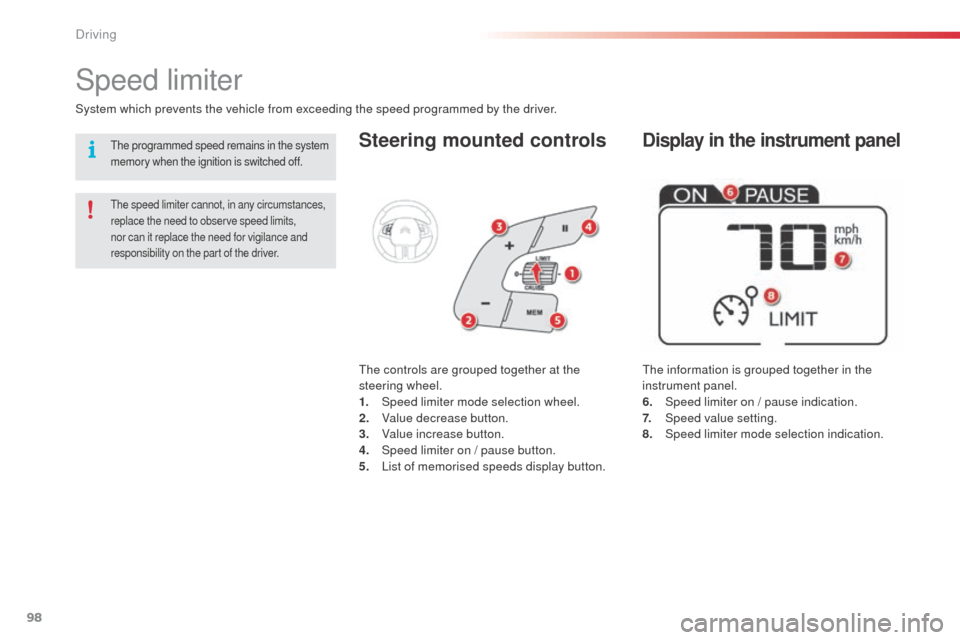display Citroen C4 CACTUS RHD 2014 1.G Owner's Guide
[x] Cancel search | Manufacturer: CITROEN, Model Year: 2014, Model line: C4 CACTUS RHD, Model: Citroen C4 CACTUS RHD 2014 1.GPages: 331, PDF Size: 8.56 MB
Page 74 of 331

72
In cold weather with the engine cold,
the air flow is increased gradually until
the system has warmed up, in order
to limit the delivery of cold air into the
passenger compartment.
On entering the vehicle, if the interior
temperature is much colder or warmer
than the comfort value setting, there
is no need to alter the value displayed
in order to reach more quickly the
required level of comfort. The system
compensates automatically and
corrects the temperature difference as
quickly as possible.
This setting is associated with AUTO mode
only. However, on deactivation of AUTO mode,
the last setting used remains on.
Changing the setting does not reactivate AUTO
mode if deactivated. To change the current setting press the button
for the desired mode: "Soft ": provides soft and quiet
operation by limiting air flow.
" Normal ": offers the best
compromise between a comfortable
temperature and quiet operation
(default setting).
" Fast ": provides strong and effective
air f low.
Automatic programme mode
setting
F Go to the secondary page by pressing this button to
modulate the automatic comfort
programme, choosing one of the
modes offered.
Comfort
Page 75 of 331

73
You can modulate the distribution of air in the
passenger compartment using these three buttons.
Air flow adjustment
Avoid driving for too long with the
ventilation off (risk of misting and
deterioration of air quality).
Air distribution adjustment
F Press one of these buttons to increase or decrease the air flow.
The symbol for air flow (a fan) fills progressively
according to the air flow setting made.
By reducing the air flow to minimum, you are
stopping ventilation.
" OFF " is displayed alongside the fan. Windscreen.
Centre and side vents.
Footwells.
Each press on a button activates or deactivates
the function.
Resuming manual control
You can manually adjust the air flow and
distribution.
F
P
ress the "AUTO" button to
activate the automatic comfort
programme again.
As soon as you modify a setting, the automatic
comfort programme is deactivated.
For a uniform distribution in the
passenger compartment, all three
buttons can be pressed simultaneously.
3
Comfort
Page 88 of 331

86
Starting - Stopping the engine
F Insert the key in the ignition switch. The system recognises the starting code.
F
T
urn the key fully towards the dashboard to
position 3 (Starting) .
F
W
hen the engine starts, release the key.
Starting
Avoid attaching heavy objects to the
key, which could pull down in it when in
the ignition switch and cause faults.Key left in the "Ignition on"
position
On opening the driver's door, an alert
message is displayed, accompanied by an
audible signal, to remind you that the key is
still in the ignition switch at position 1 (Stop) .
F Immobilise the vehicle.
F
T urn the key fully towards you to
position 1 (Stop) .
F
R
emove the key from the ignition switch.
Switching off
If the key has been left in the ignition
switch at position 2 (Ignition on) ,
the ignition will be switched off
automatically after one hour.
To switch the ignition back on, turn the
key to position 1 (Stop) , then back to
position 2 (Ignition on) .
Driving
Page 92 of 331

90
Electronic gearbox
N Neutral: with your foot on the brake, press this control to put the gearbox into neutral
and for starting the engine.
D
D
rive: press this control to engage for ward
drive with automatic operation of the gears,
R
R
everse: with your foot on the brake, press
this control to engage reverse
Control panel
F Press the back of the paddle to the right of the steering wheel to
change up .
Steering mounted controls
The steering mounted paddles do not
allow neutral to be selected, or reverse
gear to be engaged or disengaged.
Five or six-speed electronically controlled gearbox which offers the comfort of automatic control of the gears, without any action by the driver.
You can temporarily take control of gear changes at any time, using the steering mounted control paddles.
F
P
ress the back of the paddle to
the left of the steering wheel to
change down .
Display in the instrument panel
F Place your foot on the brake
when this warning lamp flashes.
N
Neutral
D and 1 2 3 4 5 / 6
D
rive (for ward drive) and
the gear engaged.
R
Reverse
Driving
Page 97 of 331

95
Stop & Start
Operation
Going into engine STOP mode
The "ECO" warning lamp comes on
in the instrument panel and the engine
goes into standby automatically:
-
w
ith a manual gearbox , when stationary,
in neutral, and you release the clutch
pedal.
-
w
ith an electronic gearbox , when
stationary or at speeds below 5 mph
(8
km/h) (depending on version), in neutral
(control on N ) or when you press the brake
pedal.
Never refuel with the engine in STOP
mode; you must switch off the ignition
with the button. For your comfort, during parking
manoeuvres, STOP mode is not
available for a few seconds after
coming out of reverse gear.
STOP mode does not affect the
functionalities of the vehicle, such as for
example, braking, power steering...
Special cases: STOP mode not
available
STOP mode is not invoked principally when:
- the driver's door is open,
-
t
he driver's seat belt is not fastened,
-
t
he vehicle has not exceeded 6 mph
(10 km/h) since the last engine start by the
driver,
-
t
he engine is needed to maintain a
comfortable temperature in the passenger
compartment,
-
d
emisting is active,
-
s
ome special conditions (battery charge,
engine temperature, braking assistance,
ambient temperature...) where the engine is
needed to assure control of a system.
In this case, the "ECO" warning lamp
flashes for a few seconds then goes
of f.
This operation is perfectly normal.
The Stop & Start
system puts the engine temporarily into standby - STOP mode - during stops in the traffic (red lights, traffic jams, or other...).
The
engine restarts automatically - START mode - as soon as you want to move off. The restart takes place instantly, quickly and silently.
Per fect for urban use, the Stop & Start system reduces fuel consumption and exhaust emissions as well as the noise level when stationary.
Stop & Start time counter
A cumulative time counter for periods
in STOP mode during a journey.
It is displayed in the trip computer (accessible via
the " Driving assistance " menu of the touch screen
tablet).
It resets to zero every time the ignition is switched on.
5
Driving
Page 99 of 331

97
A fault with the system is signalled
in the "Driving assistance " menu
(primary page) of the touch screen
tablet.
Operating fault
In the event of a fault with the
system, the indicator lamp in the
Stop & Start
button flashes for a few
moments, the stays on continuously.
If you press this button to reactivate the
system, the indicator lamp flashes again for a
few moments and then stays on continuously.
The Stop & Start system can be deactivated in
the touch screen tablet.
Deactivation
If the system has been deactivated in STOP
mode, the engine restarts immediately.
When driving on a flooded road, it is
recommended that the Stop & Start
function be deactivated and that you
drive very slowly. The system can be reactivated in the touch
screen tablet.
Reactivation
The system is reactivated automatically
every time the engine is started by
the
driver.
F
P
ress on " Stop & Star t ".
F
Sel
ect the " Driving assistance "
menu.
The indicator lamp in this button comes on
continuously. Pressing this button again reactivates
the Stop & Start system. The
indicator lamp in the button goes off.
Have it checked by a CITROËN dealer or a
qualified workshop.
In the event of a fault in STOP mode, the vehicle
may stall.
All of the instrument panel warning lamps come on.
Depending on version, an alert message may
also be displayed, asking you to change to
neutral (control on N) and put your foot on the
brake pedal.
You must switch off the ignition, then start the
engine again.
5
Driving
Page 100 of 331

98
Steering mounted controls
The information is grouped together in the
instrument panel.
6.
S
peed limiter on / pause indication.
7.
Spe
ed value setting.
8.
Spe
ed limiter mode selection indication.
Speed limiter
System which prevents the vehicle from exceeding the speed programmed by the driver.
The speed limiter cannot, in any circumstances,
replace the need to observe speed limits,
nor can it replace the need for vigilance and
responsibility on the part of the driver.
The controls are grouped together at the
steering wheel.
1.
Spe
ed limiter mode selection wheel.
2.
V
alue decrease button.
3.
V
alue increase button.
4.
S
peed limiter on / pause button.
5.
L
ist of memorised speeds display button.
Display in the instrument panelThe programmed speed remains in the system
memory when the ignition is switched off.
Driving
Page 101 of 331

99
Switching on / Pause
F Turn wheel 1 to the "LIMIT" position: the
speed limiter mode is selected but is not
switched on (Pause).
F
S
witch the speed limiter back on by
pressing button 4 , if the speed displayed
is suitable (by default, the last speed
programmed).
F
Y
ou can temporarily stop the the speed
limiter by pressing button 4 again: the
display confirms that it has been stopped
(Pause). After first selecting speed limiter mode (wheel 1
in position "
LIMIT"), you can modify the speed
setting by:
-
a p
ress on button 5
:
F
t
he six speeds memorised are displayed
in the touch screen tablet,
F
c
hoosing a speed: it is displayed in the
instrument panel.
T
he selection screen closes after a few
moments. Speed limits can be memorised in the
"Driving assistance"
menu.
For more information on the list of
memorised speeds, refer to the
"Memorising speeds" section.
You do not have to switch the speed
limiter on in order to set the speed.
The speed limiter is switched on
manually: it requires a programmed
speed of at least 20 mph (30 km/h).
Adjusting the speed limit
setting
Or:
- u sing buttons 2 and 3 , increasing or
decreasing the speed displayed:
F
b
y successive short presses, to modify
by + or - ½ mph (1 km/h),
F
b
y a maintained press, to modify in steps
of + or - 3 mph (5 km/h).
5
Driving
Page 102 of 331

100
On sharp acceleration, as when
descending a steep hill, the speed
limiter will not be able to prevent
the vehicle from exceeding the
programmed speed.
The limiter is temporarily deactivated
and the displayed programmed speed
flashes.
An audible signal accompanies the
flashing of the programmed speed
when exceeding the speed is not due to
an action by the driver.
The use of mats not approved by
CITROËN may inter fere with the
operation of the speed limiter.
To avoid any risk of jamming of the
pedals:
-
e
nsure that the mat is secured
c o r r e c t l y,
-
d
o not fit one mat on top of another.
Flashing of the dashes indicates a fault with the
speed limiter.
Have it checked by a CITROËN dealer or a
qualified workshop.
Operating fault
Switching off
F Turn wheel 1 to the "0" position. T
he display of information related to the
speed limiter disappears.
F
Press
firmly on the accelerator pedal,
going beyond the point of resistance,
to
exceed the programmed speed limit.
The speed limiter is deactivated temporarily
and the displayed programmed speed flashes.
Temporarily exceeding the
programmed speed
As soon as the vehicle's speed returns to the
programmed value, the limiter operates again:
the display of the programmed speed becomes
steady again. An audible signal accompanies the
flashing of the programmed speed
when exceeding the speed is not due to
an action by the driver (steep hill...).
Driving
Page 103 of 331

101
Steering mounted controls
The information is grouped together in the
instrument panel.
6.
C
ruise control pause / resume indication.
7.
C
ruise speed setting.
8.
C
ruise control mode selection indication.
Cruise control
System which automatically maintains the speed of the vehicle at the value programmed by the driver, without any action on the accelerator pedal.
The cruise control system cannot, in any
circumstances, replace the need to observe speed
limits, nor can it replace the need for vigilance and
responsibility on the part of the driver.
You are advised to keep your feet near the pedals
at all times.
The controls of this system are grouped
together at the steering wheel.
1.
C
ruise control mode selection wheel.
2.
D
ecrease value or speed setting on the fly
button.
3.
I
ncrease value or speed setting on the fly
button.
4.
C
ruise control pause / resume button.
5.
M
emorised speeds display button.
Display in the instrument panelSwitching off the ignition cancels any
programmed speed value.
5
Driving